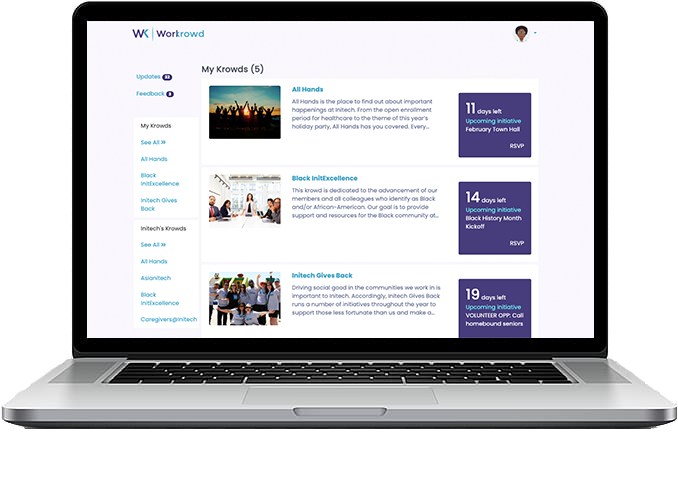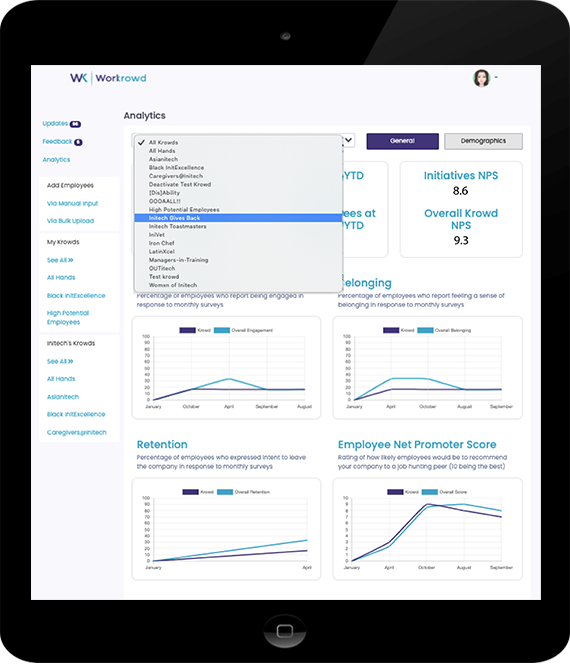When it comes to employee engagement and retention, having the right tools is crucial. In today’s rapidly changing world of work, you have to cater to a wide range of team member needs. At the same time, you still have to cover all the standard bases as well.
To achieve all this without the help of digital tools would take more hours than there are in a day. But what should you be looking for to fill out your toolbox?
Workrowd is dedicated to helping organizations improve their employee experience and create real, lasting connections across their workforces. Our tool suite drives employee engagement and retention while helping you keep all the balls in the air.
As you determine which employee engagement and retention tools to use at your organization, consider the benefits you’re looking to achieve. For example, here are just some of the ways Workrowd helps companies and their teams:
Simplified onboarding
Onboarding a new employee can be stressful. There’s so much you have to introduce them to, it’s easy to miss things related to culture and engagement.
Workrowd makes it easy to immerse new team members in your company culture from day one. Whether they’re remote, hybrid, or on-site, everyone gets equal access.
All you have to do is add them to the platform when you add them to your other systems. Then, they can scroll through all your organization’s employee groups, programs, and events in one place, at their own speed. They won’t have to dig through chat channels, trawl your intranet, or hope to hear about things from colleagues.
Making sure team members feel welcome and included from day one is key to employee engagement and retention.
Deeper work relationships
When someone has friends at work, they’re more than twice as likely to be engaged. Employee engagement impacts everything from employee happiness, to experience, to productivity, to retention.
So, while it may seem like a small thing, ensuring team members feel like they belong where they work could actually be one of the biggest contributors to your business’s ability to retain employees and make a profit.
Using Workrowd, team members can connect with colleagues and take full advantage of all your employee programming. With one-click signups, personalized experiences, and more, it couldn’t be easier to get involved.
Workrowd empowers team members to engage with anything from mindfulness sessions to Toastmasters clubs to employee resource groups and everything in between. Relationships built in these spaces help ensure deep bonds between colleagues that drive employee engagement and retention.
Lower churn rate
How many times have you heard someone say they stayed somewhere because of the people? It’s a common refrain, and for good reason. Even if we don’t always love what we’re doing, if the people are great, it can make it worth it.
We spend more time with our work colleagues than the people we live with. So, is the importance of employees’ relationships with each other really that surprising?
If an employee is more engaged and connected, they’re more likely to stick around. Their job will feel less like something they do just to pay the bills. It will become an important part of their community, life, and identity.
Increased satisfaction
Net Promoter Scores (NPS) are a great way to find out about employees’ satisfaction. Workrowd automatically tracks the NPS for each of your employee events, groups, and programs. This way, you always know where you stand.
Armed with this information, you can spend your time where it matters most – improving programs with low scores, and championing those that are doing well. This way, you can take a data-driven approach to increasing employee engagement and retention.
Employees are in control, too. They can join whatever initiatives they like, mute notifications, check in at certain times of day, etc.; it’s totally flexible based on what they need.
This ability to personalize the employee experience can greatly increase your NPS. By equipping team members to self-serve, each individual can build a work life they love from day one.
Reduced admin work
Some people enjoy admin tasks, but nobody can deny that they’re a huge time sink.
When you factor in multiple topics and sources of data, it can be a real headache to manage everything for employee engagement, talent management, DEI, and company culture.
By centralizing everything, and automating tasks like data collection and analysis, Workrowd reduces how much time you spend on admin tasks.
The platform collects data through activity tracking, post-initiative surveys, and ongoing pulse surveys, then pulls it into customizable dashboards.
You can view KPIs, progress towards those KPIs, employee demographics, program budgets, and more. It all depends on what’s relevant for your organization.
Workrowd also frees you from having to manage membership lists manually, share materials in multiple places, juggle calendars, etc. The platform handles it all.
With Workrowd, you can set it, forget it, and move on with the work that really matters, while staff are just a click away from a richer employee experience.
Personalized experiences
Nowadays, personalization is so important. Employees are used to personalization from consumer brands, so they expect it at work, too.
Luckily, with Workrowd, it’s not just admins who get personalized dashboards—employees do, too.
They just click to register for all the programs, groups, and topics that interest them. This all gets added to their personalized dashboard so they have an all-in-one view of everything they have coming up.
Especially with people working across so many times and locations, having this collective touchpoint can go a long way towards increasing employee engagement and retention.
One-stop shopping
Workrowd centralizes all your employee initiatives, so that every team member can take full advantage of everything you have to offer.
No more employees slipping through the cracks or missing out on important opportunities. Give them a one-stop shop for culture and engagement.
All your talent initiatives get equal billing, from social impact, to diversity and inclusion, to learning and development, health and wellness, innovation, recreation, and more.
Workrowd’s flexible structure makes it highly adaptable to your company’s specific culture. You can effectively establish a town square for all team members that’s accessible from anywhere.
Automated insights
Modular analytics and automated surveys allow you to see, at a glance, which programs are driving impact and which ones need more support, empowering you to optimize your strategy and spending.
When exploring tools to improve employee engagement and retention, data tracking and analytics should be a key consideration.
Easy localization
The option to organize Workrowd by region or office means it’s easy to ensure employees’ portals only show them the groups, programs, and events available to them, including company-wide initiatives. Perfect for a global or hybrid organization.
Evolving community knowledgebase
When someone leaves, their knowledge leaves with them. This can create real challenges as you have to train someone new in their role. What’s often overlooked though, is that you also have to find new people to take over the other roles that person may have held in terms of culture, group leadership, etc.
Workrowd allows you to create a knowledgebase so that when someone who’s in charge of a group or activity does leave, their successor can get up to speed much faster. This way, that group or program doesn’t collapse, or experience major setbacks.
Increased productivity and collaboration
Is it any surprise, when people work together on extracurriculars, they’re more likely to collaborate better on work projects, too?
A greater sense of community throughout the business helps with interdepartmental relationships, giving everyone and everything a boost.
Workrowd also increases participation in and effectiveness of employee groups, programs, and events, driving employee engagement and retention throughout your business.
Conclusion
These are just some of the benefits you can gain from tapping into the right tools to increase employee engagement and retention.
Workrowd’s user-friendly platform is designed to help your people find their people, no matter where or when they work. Our suite of tools ensures you can maximize the impact of your employee groups, programs, and events, making the most of your investment.
Don’t just take our word for it, though. Take it from one of our customers: “Workrowd has been an incredible asset allowing us to be more connected as a team. Implementation was seamless and the value of the tool continues to grow every day with real time input from our employees and management team.”
If you’d like to learn more about how you can partner with Workrowd to increase employee engagement and retention, send us a note to hello@workrowd.com.

















